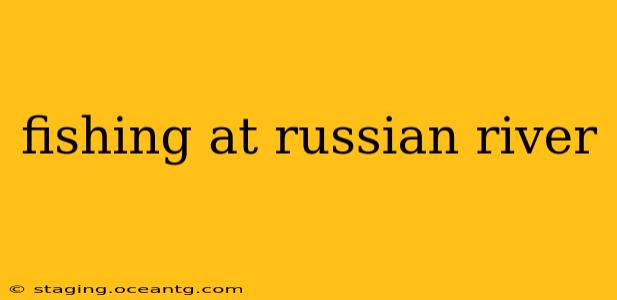The Russian River, a scenic waterway winding through Sonoma County, California, offers a diverse and rewarding fishing experience. Whether you're a seasoned angler or a beginner casting your line for the first time, this guide will equip you with the knowledge to make the most of your trip. From understanding the best fishing spots to mastering the techniques for landing your catch, we'll cover everything you need to know about fishing the Russian River.
What are the best times of year to fish the Russian River?
The best time to fish the Russian River depends on the species you're targeting. Steelhead fishing generally peaks during the winter months (November-March), while salmon runs occur in the fall (September-November). Bass fishing is best during the warmer months (spring through fall). The river's water levels and temperature also play a significant role in fishing success, so checking current conditions before heading out is highly recommended.
What kind of fish can I catch in the Russian River?
The Russian River is home to a variety of fish species, making it a popular destination for anglers of all skill levels. Some of the most commonly caught fish include:
- Steelhead: These powerful, migratory fish provide an exhilarating fight.
- Salmon: Chinook and Coho salmon can be found in the river during their spawning runs.
- Bass: Largemouth and smallmouth bass are abundant in the river's calmer sections.
- Trout: Rainbow trout are also present, especially in the upper reaches of the river.
- Catfish: Channel catfish can be found throughout the river.
What are the best fishing spots on the Russian River?
The Russian River offers a variety of fishing spots, each with its own unique characteristics. Some popular locations include:
- Healdsburg area: This section of the river offers good access and a variety of habitats.
- Forestville area: Known for its steelhead and salmon runs.
- Guerneville area: A popular spot for bass fishing.
- The lower river: This section offers diverse fishing opportunities depending on the season and water conditions.
It's important to note that access to certain areas of the river may be restricted, so it's crucial to check local regulations and obtain any necessary permits before fishing.
What are the fishing regulations for the Russian River?
Before you cast your line, it's essential to familiarize yourself with the current fishing regulations for the Russian River. These regulations are designed to protect the river's fish populations and ensure sustainable fishing practices. Check the California Department of Fish and Wildlife (CDFW) website for the most up-to-date information on licenses, limits, and size restrictions. Ignoring these regulations can result in fines.
What kind of fishing gear do I need for the Russian River?
The type of fishing gear you'll need will depend on the species you're targeting. However, some essential items include:
- Fishing rod and reel: Choose a rod and reel appropriate for the type of fish you're targeting.
- Fishing line: Use a strong line suitable for the size and species of fish.
- Hooks and lures: Select hooks and lures that are appropriate for the species you're targeting and the fishing conditions.
- Bait: Popular baits include worms, salmon eggs, and lures.
- Waders (optional): Waders can be helpful for accessing deeper areas of the river.
What are some tips for successful fishing on the Russian River?
- Research the river: Understanding the river's flow, depth, and habitat is key to success.
- Check weather and water conditions: Avoid fishing in harsh weather conditions or when water levels are too high or too low.
- Be patient: Fishing requires patience and persistence.
- Respect the environment: Practice Leave No Trace principles and help maintain the river's health.
Fishing the Russian River offers a unique and unforgettable experience. By understanding the river's characteristics, adhering to regulations, and employing the right techniques, you can significantly increase your chances of a successful and enjoyable fishing trip. Remember to always prioritize safety and responsible fishing practices.
